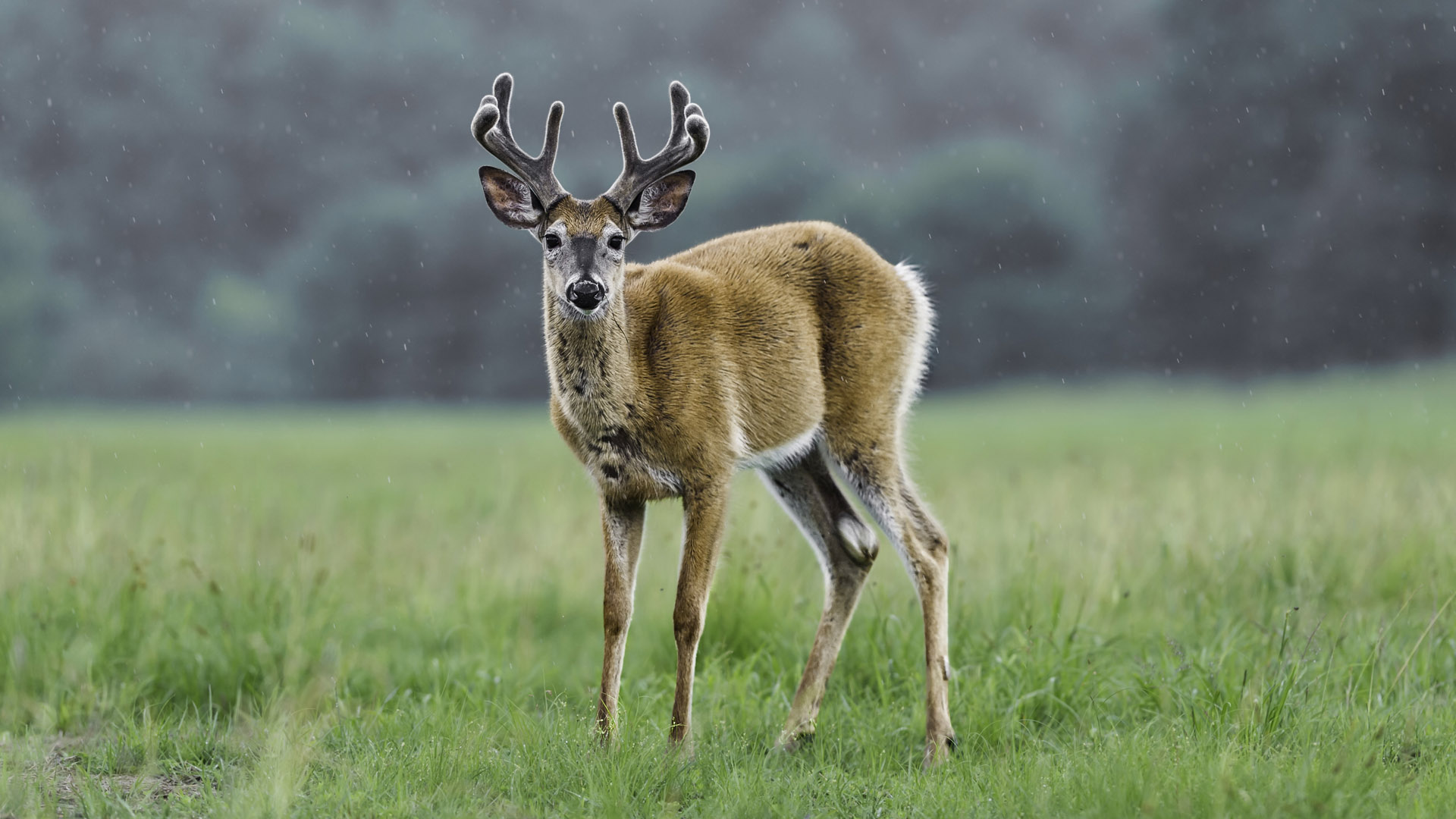Tucked in the far northeast corner of the United States, nestled beneath two Canadian provinces, lie the sweeping forests and coastline of Maine. The residents here have strong ties to the land, with many families having worked the same farms and woodlots for generations. So, as a wildlife ecologist and environmental communications researcher, I listen closely when they talk about their rising concern over ticks. Repeatedly, I hear that ticks weren’t a concern until the last few years. Now, everyone seems to know someone who has contracted Lyme disease, one of several tick-borne diseases rolling northward across the region as the climate warms.
Similar stories are playing out in other parts of the country. The Centers for Disease Control and Prevention estimates that 300,000 Americans contract Lyme disease each year, mostly in the Northeast and Midwest. Some people are lucky and manage to receive treatment early, despite the confusing process for diagnosing the disease. Others are less fortunate and report battling a series of crippling symptoms for years.
There’s a relatively straightforward way to curtail the spread of Lyme disease. Research has shown that by appropriately managing the population of deer, the primary hosts of Lyme-carrying ticks, rates of Lyme disease in the northeastern U.S. could be reduced by as much as 80 percent. But due to an antiquated federal law, the state agencies tasked with managing wildlife populations have another, conflicting interest at heart: hunting. Not only does this law have the effect of prioritizing hunting concerns over ecological and public health concerns, but it has put the agencies themselves on the path to bankruptcy.
To be clear, the U.S.’s skyrocketing deer population is not solely to blame for the rise of tick-borne diseases. Other factors also play a role, including warmer winter temperatures and increasing relative humidity due to climate change. But the deer population is the primary culprit: The deer tick, responsible for transmitting the bacterium that causes Lyme disease, feeds primarily on the blood of deer during the adult stage of its life cycle, and several regional studies have shown that there is a direct correlation between deer population density and the prevalence of Lyme disease.
Colleagues of mine at the University of Maine recently showed that tick populations and the risk of Lyme disease can be cut substantially by maintaining the deer population below about 10 deer per square mile. When the population is below four deer per square mile, even the secondary effects of climate change become irrelevant to Lyme risk. Yet, the Maine Department of Inland Fisheries and Wildlife continues to set deer population targets above these thresholds, at 10 to 15 deer per square mile in the northern part of the state and 15 to 20 deer per square mile in the southern part of the state. The reasons have little to do with wildlife conservation and everything to do with economics.
Like other state wildlife agencies in the U.S., the Maine Department of Inland Fisheries and Wildlife was established with the original purpose of regulating hunting and fishing. And like most wildlife agencies, it is funded largely via these activities — through license sales, through an 11 percent tax on sporting arms, ammunition, and archery equipment, and through a 10 percent tax on handguns, as prescribed by the 1937 Pittman-Robertson Act. The revenue is distributed to states based on their land area and their population of licensed hunters. Funding support for a state’s fish and wildlife agency is therefore closely tied to the number of licensed hunters in that state.
But those hunters constitute a slim demographic. Nationally, only about 4 percent of American adults hunt. Of those, roughly 97 percent are white and 90 percent are male. Due to their status as a primary source of funding for wildlife agencies, this small group exerts disproportionate influence over wildlife management planning. As a result, wildlife agencies have a strong incentive to maintain deer — a favored species for hunting — at numbers far larger than would naturally occur in a healthy ecosystem. Although the agencies often claim that their policy decisions are nevertheless based on science, research has shown that those claims do not always hold up to scrutiny.
The repercussions of this conflict of interest go beyond Lyme disease. Bloated deer populations come with a long list of concerns, including increased risks of vehicle collisions, higher rates of disease transmission among deer herds, and even decreases in songbird populations. Although the sight of a deer grazing in a backyard might be taken by many casual observers as a sign of a healthy ecosystem, wildlife ecologists recognize it as a disconcerting signal that the animals are becoming domesticated. By hunting deer’s predators to near extinction, humans have not only changed their numbers but also their behavior. We have disrupted what scientists refer to as the “ecology of fear.”
The Pittman-Robertson Act has often been used by the gun lobby as leverage to win policy debates and evade regulation. One example is the continued use of poisonous lead ammunition, which threatens the health of wildlife and can contaminate soil and drinking water. The ammunition is especially harmful to vultures, coyotes, and other scavengers — members of nature’s “clean-up crew” that help to limit the spread of diseases like rabies. Ecologists and public health advocates have pushed to eliminate the use and sale of lead ammunition, but their efforts have consistently been met with strong opposition from the gun lobby and hunting community. To win public support, pro-gun lobbyists have proclaimed that every sale of a lead bullet supports wildlife conservation efforts through the Pittman-Robertson Act, when in reality, every sale does direct harm to natural ecosystems and indirect harm to public health.
The Pittman-Robertson Act isn’t merely outdated environmental policy; it is also fiscally unsustainable. A nationwide survey by the U.S. Fish and Wildlife Service estimates that the number of hunters declined by more than 18 percent between 1991 and 2016. There are roughly half as many hunters today as there were 50 years ago. This number is expected to continue to dwindle, and as it does, so will revenue streams for state wildlife agencies. Already, the Wisconsin Department of Natural Resources has been forced to address a roughly $4 million per year funding gap by reducing staffing levels, hampering their efforts at habitat conservation and invasive species control.
Increasingly, Americans are taking to the outdoors not to hunt but to enjoy other forms of recreation. More than a third of all Americans now participate in activities like bird watching, wildlife photography, or visiting parks for the purpose of observing animals. These recreationalists reported spending nearly $76 billion on related expenses — including binoculars, tents, and lodging — in 2016. Those numbers will come as little surprise to anyone who has noticed the crowds in our National Parks or the increased demand for hiking permits on trails like the Pacific Crest Trail.
This cultural shift in the way that we value the outdoors presents an opportunity to simultaneously shore up state wildlife agencies’ financial outlook and better align their interests with those of science and health. A tax on non-hunting outdoor gear could not only replace the revenue currently collected under the Pittman-Robertson Act but surpass it — and continue to grow. And, importantly, it would foster a more inclusive approach to wildlife conservation by removing the disproportionate influence of the hunting community.
Good governance requires accepting cultural shifts and continuously finding ways to update outdated policies to match a society’s changing needs. For the sake of our ecosystem and our public health, it’s time we abandon the Pittman-Robertson model and broaden our wildlife conservation priorities from regulating game species to protecting the full range of biodiversity.
Elyse DeFranco is a wildlife ecologist and environmental communications researcher. She is currently based in Maine.












Comments are automatically closed one year after article publication. Archived comments are below.
I am a Maine resident who hunts and I agree with the author that something needs to be done about the deer population and the disproportionate influence hunters have. I do not think that the Pittman-Robertson Act needs to be abandoned, but there absolutely needs to be additional sources of funding, it should not fall mostly on those that hunt, fish, and trap. As the author stated by having additional sources of funding, conservation would be more inclusive. The issue of deer populations can be complex, currently the state allows hunters to buy additional doe tags, as a way to reduce the population to the goals set forth by the state but as a hunter and one who is studying conservation and management, the seasons need to be adjusted to allow more time, the hunting season is 79 days across all the seasons and one of the larger issues is the amount of posted land in the southern portion of the state. While some landowners do allow hunting, there are those that do not, restricting where one can hunt. In what is called Wildlife Management District 24 and 25,Along the coast of Maine is a higher populated area, it is harder to hunt, more posted land, some towns only allow shotguns, and there are areas that are archery only. Compounding these make it harder to hunt and harvest deer, leading to overpopulation in local areas. Again the PR should not be abandoned, updated yes, additional sources of funding are needed, to make conservation more inclusive so everyone can share in it.
Thank you for this thoughtful overview of wildlife conservation funding. More inclusive wildlife governance is definitely needed. The state game departments and commissions make an effort to exclude non-consumptive attitudes. This is a crisis in governance. As with most issues, these problems will likely be ignored as long as they possibly can be.
You talk about reducing the deer density, but how would you do that without hunting? You could always reintroduce more predators, but I don’t think that would be wildly popular. Especially considering the highest deer densities typically occur in urban environments.
If you increase the amount of deer taken by hunters every year to reduce the population you would as said reduce the demand for hunting due to lack of good hunting opportunity. This would eventually lead to an increase in deer population due to lack of hunting. Creating a cyclical effect. Maybe the deer herd is managed to keep the density fairly stable with stable hunting pressure.
Spot on. Moreover, as wildlife management agencies continue to be funded primarily from hunting and fishing licenses, non-game species get the shaft. Worse, big carnivores like mountain lions and wolves are viewed as enemies. So, you end up with situations like we now have in Colorado, where wolf reintroduction is supported by science and popular opinion, but the state Parks & Wildlife Department won’t get behind it, so now there’s a ballot question slated for November.
No, wolf reintroduction is supported by out of state and out of country donors. There is simply not the geography or the elk/deer herd to support full-scale wolf reintroduction on the Western Slope of Colorado. The science is not there.
Additionally, depradation reimbursements given to ranchers to due the inevitable wolf-lifeatock interactions will destroy the budget of Colorado Parks and Wildlife.
Also if you look at MDIFW’s latest budget, quite a large share of their funding comes from the General fund-I don’t recall the exact figure , but I believe it was around 60%
The spread of Lyme is also closely related to turkey populations, and the original stock used to reintroduce turkeys came from Connecticut-ground zero for Lyme.
Black legged ticks use birds and small mammals as one of the vectors, and unlimited possession allowed by MDIFW on predators of that vector (fox, coyote, skunk, raccoon) is also having an affect on the spread of the disease.
For starters, “Now, everyone seems to know someone who has contracted Lyme disease, one of several tick-borne diseases rolling northward across the region as the climate warms.” can be taken with several grains of salt. Lyme Disease seems to be the “disease du jour” these days,with people relaying dramatic stories of misdiagnosis, “chronic Lyme”, etc. Many of these cases are figments of the imagination, with no proof existing of this infection.
Hi Sandy, thanks for your comment. I’m not an expert on Lyme Disease, but here is a well written article by the director of the Johns Hopkins Lyme Disease Research Center explaining more on this topic. https://theconversation.com/chronic-lyme-disease-does-it-exist-129288
I lived in Maine for 8 yrs., and know full well just how entrenched the gun/killing lobby is. Many of us in New Mexico are also fighting this battle with the antiquated pro-hunting/trapping & ranching mentality. We will not give up, we are growing in number, and those who continue to slaughter wild animals for fun & profit are dwindling. The “rural lifestyle” argument is often used to perpetuate so-called “traditions” which came out of the massive bloodbath of the 1800’s in the West. Dan Flores, in his book “The American Serengeti said “it was a slaughterhouse.” Not only were the great herds of bison, elk, pronghorn almost driven to extinction, but those wildlife who followed them for food (mountain lion, grizzly, wolves, coyotes, etc., were hunted and tortured as well. Wolves and coyotes are still ignorantly called “varmints.”
So glad to see this article. It is time to Abolish the game agencies, who continue to cater to the minority special interests.
stealtraps.com http://www.foranimals.org
This is an excellent article, but I disagree with the analysis of Pittman-Robertson funding. Hunters may be in decline, but shooters are not, and the sale of both guns and ammunition are higher than ever. Funds are derived from these sales, not from hunting.